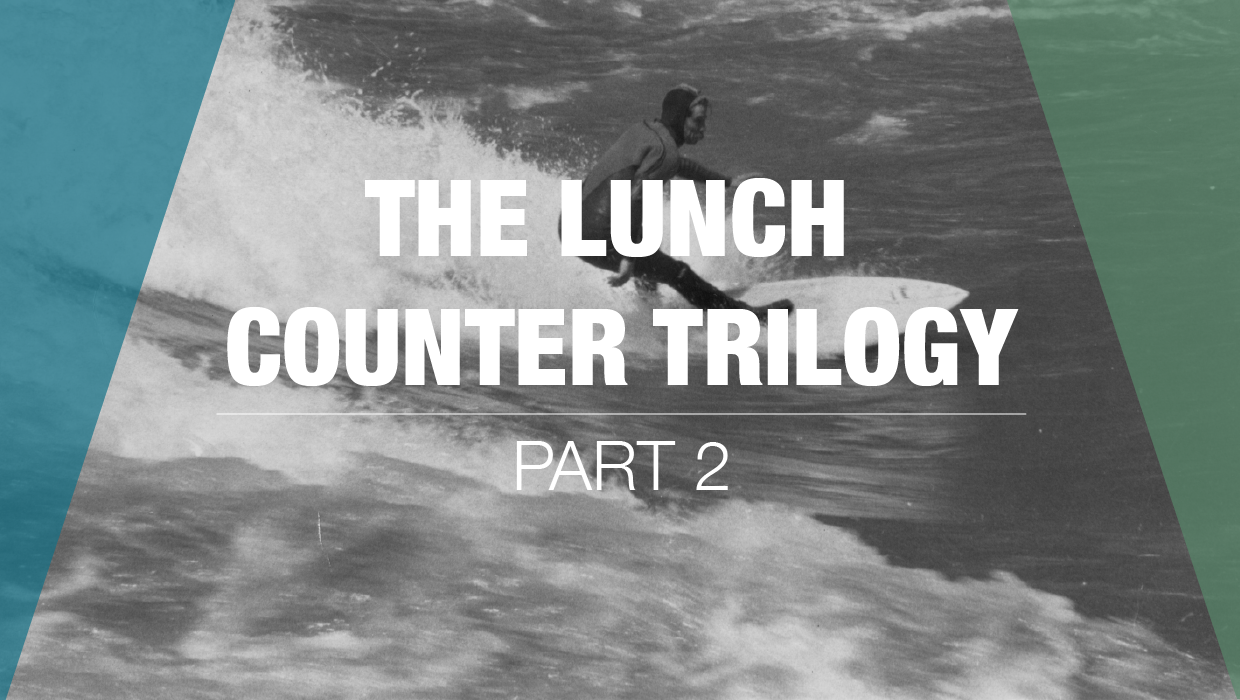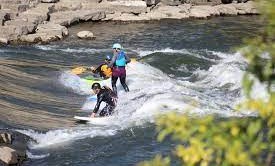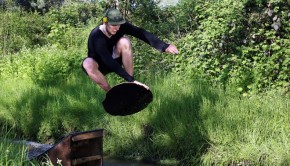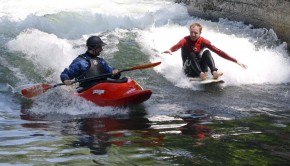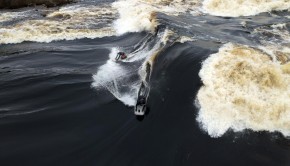The Lunch Counter Trilogy, Part 2: Camping, Big Waves & Bikinis
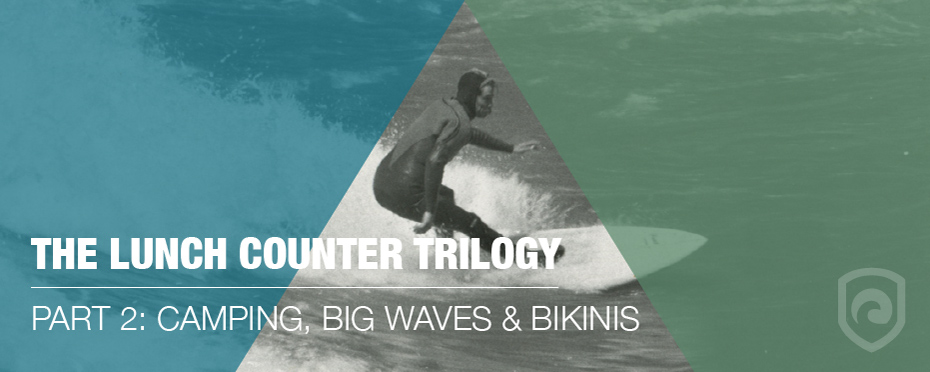
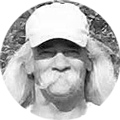
“There were a handful of hidden camping spots where the parking lot is located now. You hooked a right off the highway between two trees and onto a little dirt track that looped along the base of the drop-off. The track followed the contour along for a bit before ending up back at the road farther up canyon. It was mostly shielded from the highway noise up above, being lower and blocked by greenery. Traffic pretty much died off at night anyway, except for the occasional big truck heading north towards Hoback Junction or Jackson. Those few unwelcome sounds were mostly drowned out by the ever-present roar of the river at flood stage. That river, she be talking loud in that narrow canyon at night. That echoing white noise could lull you to sleep much like my childhood growing up next to the ocean and hearing waves always breaking. It was a great spot to camp, and best of all it was free. Most of the regulated campgrounds anywhere nearby weren’t open that early in the season anyway. Often they were still blocked with snow as they were almost all at higher elevations. Hell, we barely had the gas money most of the time, much less campground fees. We ate a lot of sandwiches and soup.
Camping rarely got crowded, even on weekends. An occasional county sheriff might drift through checking to be sure nobody was trashing the place, but for the most part we were left to ourselves. The golden rule was to pack out more than you brought in. Everybody took care of the place. You could pitch your tent isolated from other campers by all the alpine vegetation, or you could take over a more open area by circling up a camper, a couple of cars, and a tent or two. The kayakers and their family groups tended to do that. They would meet, mingle, and share around a campfire or barbecue. We got invited to join in, but that was usually after we had spent the day surfing the ‘counter with them. We had to prove our boni-fides first, so to speak.
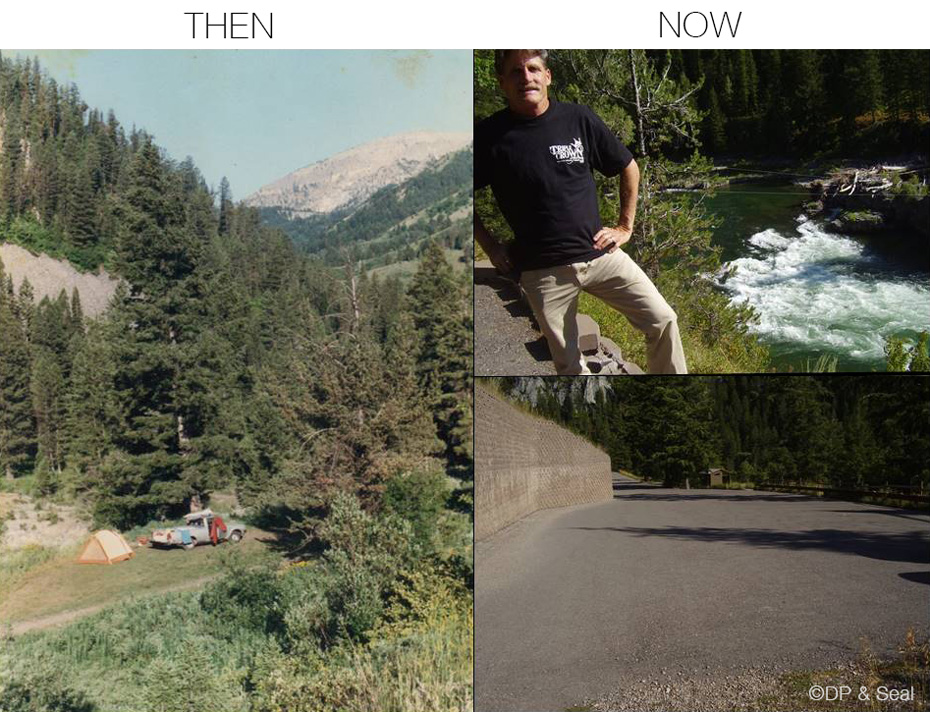

“Evenings were spent sitting around a campfire with whoever happened to be camping nearby. Strangers would share food and drink, break out instruments and play music together, read books under camp lanterns, or curl up under warm blankets and sleeping bags to talk story late into the night. I remember one trip when my troubadour musician buddy, Ardy Michaels and his dog Bojo showed up in his built for traveling pickup truck. I drifted off to sleep in my tent listening to the two of you night owl musicians types blowing harp and playing guitar until the very wee hours.
The camp spot had a discrete trail leading at an angle down-canyon along the forested cliff from the campsites right to where the surf break viewing and cheerleading rocks were. Directly above that was the highway pull-out where the buses let tourists off to walk down the myriad crumbling tracks that had been worn down the bluff over many years. We laugh about all the 35mm film photos taken by the tourists that are decaying in dusty old photo albums across the planet. We are also quite sure that the vast majority of pictures were absolutely the worst possible surf shots ever taken.
There was wildlife in abundance – deer were common. Bobcats would appear every now and then. Kingfishers, ospreys, and eagles nested in nearby cliffs, and they would regularly swoop down on the river to grab at fish. We saw moose across the river walking with their newborns, plus the big guys with huge racks on their heads. We heard the screams of cougars in the dark of night coming from somewhere across the river. Maybe there was more wildlife on that side since there wasn’t any human habitation or a road. Luckily we never encountered a bear, but we were told that it had happened to others who camped there. You just did not leave food in tents, because if it wasn’t a bear, it would be a mouse, squirrel, Jay, or some other ‘camp robber’ quick to capitalize on an opportunity.”

“I left a loaf of bread out in the tent just once, and came back to a perfectly round squirrel-sized hole chewed through the fabric wall with the remains of a wonderful meal scattered over everything inside. Oops…”
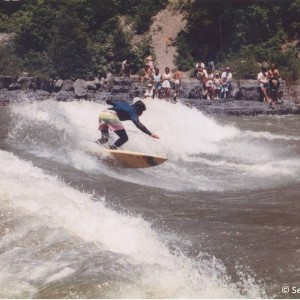 Frontside Cutback, 1991In the middle of a clean frontside cutback.© Seal & DP
Frontside Cutback, 1991In the middle of a clean frontside cutback.© Seal & DP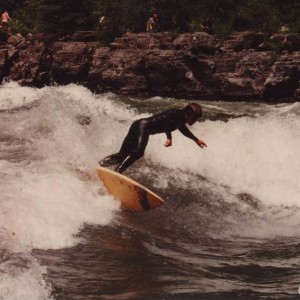 Cutback on Snake River, 1992On Seal Team Twin Fin in mellow water with sunshine.© DP & Seal
Cutback on Snake River, 1992On Seal Team Twin Fin in mellow water with sunshine.© DP & Seal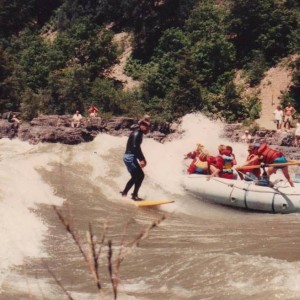 Traffic on Lunch Counter, 1990This Alpine Canyon commercial raft captain is making every effort to be sure his oar does not hit DP.© DP & Seal
Traffic on Lunch Counter, 1990This Alpine Canyon commercial raft captain is making every effort to be sure his oar does not hit DP.© DP & Seal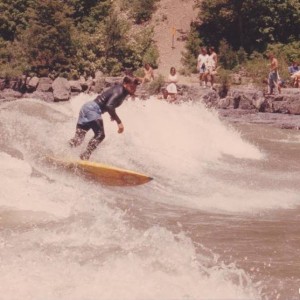 Exhale and Compress, 1990DP on Seal Team single fin on big brown water with sunshine.© DP & Seal
Exhale and Compress, 1990DP on Seal Team single fin on big brown water with sunshine.© DP & Seal

“It got very cold down by the river at night with 39′F water and the wind whistling between the down canyon cliffs towards Alpine Junction. Being at the bottom of a narrow river canyon meant night came on quickly and the sun came up late. Mornings were frosty and nights could be downright cold as air drained out of the surrounding snow-covered mountains. We tended not to get up too early – no dawn patrol surfing here. There was never a rush to surf, because long rides guaranteed leg muscles would be transformed into wet noodles or cramped beyond use by the end of the day. Once the sun dropped behind the canyon walls in the late afternoon, you were out of the water.
Wetsuit technology wasn’t anywhere near where it is now. Surfing the Snake River with the wetsuits that we had back then was just barely adequate compared to the high tech wetsuits surfers can wear in subzero temperatures now. We were often cold and it was always a challenge to warm back up between waves, even when you could lie out on the sun-heated rocks. Any little hole or worn spot would let in freezing cold water, so in many of our pictures and video clips you see we are wearing board shorts on the outside of our wetsuits. It looks a little funny, but you had to protect your wetsuit from all the wear and tear of the sharp rocks that we rested on along the riverbank.”

“Early season was when weather could be bone-cold gray and gloomy, or else turn into bright sunshine shorts weather. You could never count on good weather, especially at that time of year. We got snowed on; we got rained on; we got run off by bitter cold and wet, and had to drive the three hours all the way back home on more than just a few occasions. But early season was often when the wave broke at its very best. One weekend, in the early spring of 1991, we got completely snowed out at the camp spot before we ever set up a tent or unstrapped the surfboards from the top my new/used Jeep Cherokee. It was just too cold.”
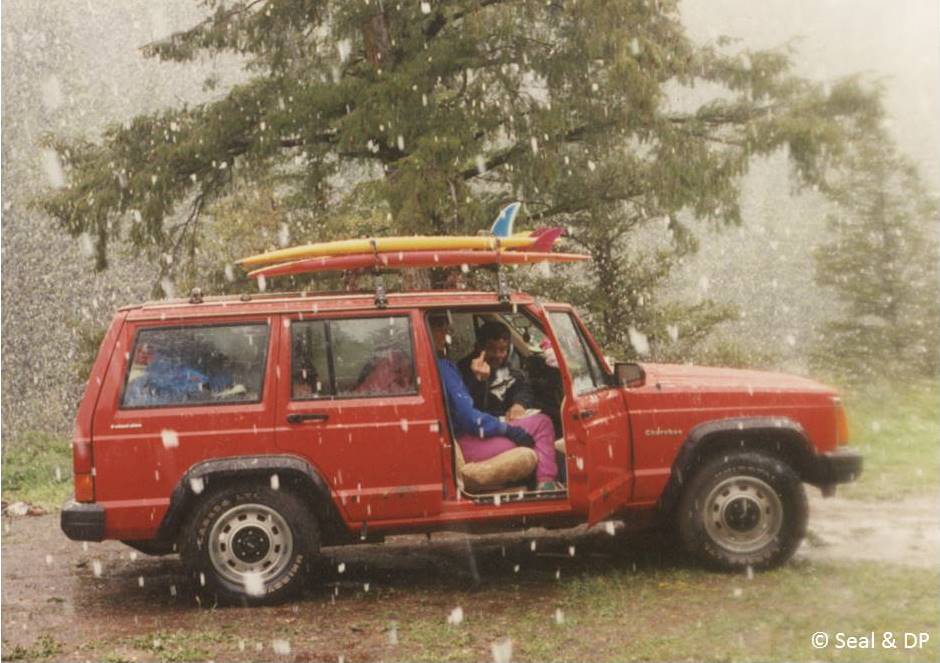

“There weren’t that many people willing to get into the water early in the season. The river was often brimming with debris knocked loose by the annual floods. The water was big and brown, and always just above freezing at that time of year. The air temperature was often about the same, and that’s without factoring in the wind chill. It was good that we had all our snowboarding clothes packed along, because we sure needed them.
We often had the river seemingly to ourselves, give or take those few hard-core early season river runners that came through mostly in pairs or groups of three or four. Many times the kayakers who showed up were there specifically to ride the waves along the same stretch of river we were riding. Their families camped with us at the usual spot, turning weekends into a little community of different souls. Some of the regulars we knew, and others we came to know. We frequently caravanned there with river rats from Northern Utah with their kayaks atop the lead truck and twin fin surfboards racked up Seal’s truck behind it. It became a pretty common sight until those same friends moved to the Oregon coast.”

“As the flows came down and the temperatures came up later in the season, Lunch Counter transformed into a hub of activity. Because it is roughly half way between the put-in and take-out points, it is a natural spot for recreational river runners to pull out their kayak, raft, rubber ducky, canoe, McKenzie boat, or whatever they floated down on to watch the Lunch Counter scene play out. Kayakers sat behind the eddy lines, punching out to grab turns in the secondary waves, or portaging their boats upstream for repeated runs through the gauntlet. What we pulled out, much to many people’s surprise, were surfboards.
The wave side of the river is only accessible to people by boat or board, so it often carried the vibe of some kind of adventurers’ club. If you were on that side of the river, you were a player, not just another tourist. Truthfully, at times it could sort of segregate people, since the river folk didn’t go over and mingle with the tourist crowd much. We were all there mostly for that wave. Okay, maybe the occasional chance to chat it up with a potential love interest sitting on the rocks across the river might draw somebody back over, or we would ferry across for lunch or an afternoon break back at the camp spot between sessions. It was always fun to catch the Lunch Counter secondary wave on your paddle back across mostly to see how long you could stay standing before the pulsating nature of that wave inescapably brought you down.”

“During early summer, it evolved into a very different place. That was the absolute party time to be there. The now long-gone parking lot along the highway side would overflow with tour buses and big RVs full of families during the day. Each disgorged hordes of camera-ready tourists that either hung over fence on the rim or hiked down the access trails to capture images from the riverbank. Women in bikinis, and those guys who were interested in women in bikinis, would be there laid out on their towels, beach chairs, or claiming the very best sitting rocks for the afternoon. It was quite the happening place by midsummer.”
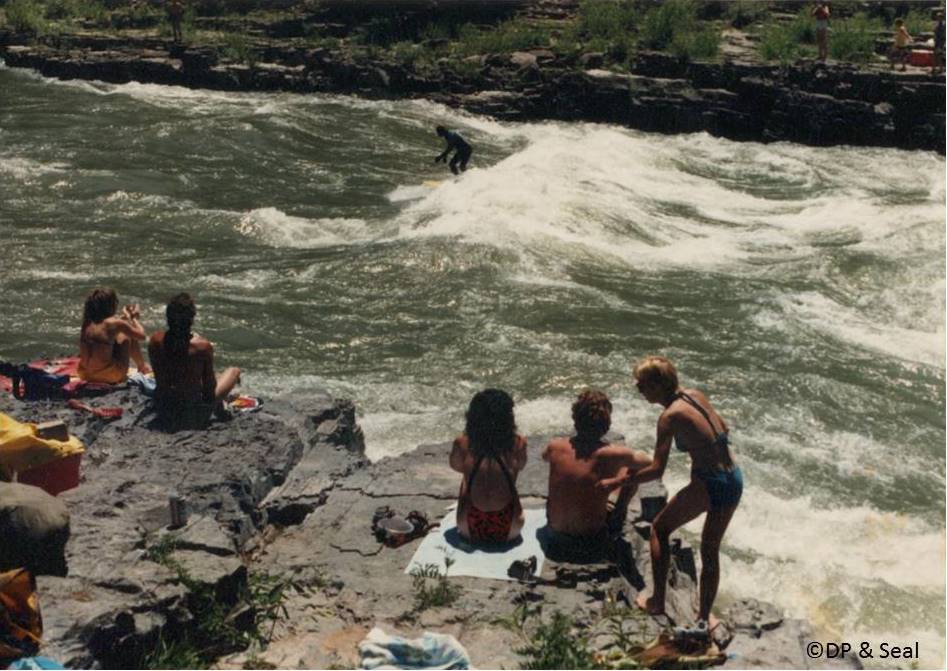

“Videographers hired by the major rafting companies were positioned strategically on the banks to document raft passenger’s grand adventure through Alpine Canyon. Raft captains spent the upriver sections verbally pumping up their passengers for the Lunch Counter Rapid. Passengers primed for adventure made for better end-of-float tips for some commercial rafters.
When the rafters floated through Lunch Counter, they would sometimes find a surfer already up and riding. We were constantly checking upstream for approaching rafts. –they had just one shot at the wave, so we did our best to move way aside to give them the right-of-way. We’d either move way over or often just kick out entirely. All the same, a minority of the commercial rafters began to think that having a surfer on the wave took away from their passenger’s exhilaration. We made it look too easy. I recall that one out-of-control commercial raft guide who took it upon himself to try to make an example out of you, Seal.”

“Oh yes, I remember that little episode. On one sunny day I happened to be on the wave when an aggressive raft guide deliberately took me out with an oar. I had moved completely out of the way over towards the rock wall, but that clearly didn’t satisfy him. The guy reached way out with his portside oar and I had nowhere to go. He smacked me hard in the leg with the spoon end. My leash tangled around the oar which jerked me off the board. His downstream momentum dragged me under the raft and pinned me there as it went through the rest of the rapid. I was completely and inescapably ensnared under the raft. I was still tangled up with that idiot’s oar when I came back to the surface on the starboard side of the raft downriver in the flat water section. Maybe a 20 or 30 second hold down which is a long time in the dark under a raft!
I must admit I was soundly pissed off. Fear and adrenalin will do that. I wanted to pound on him just a bit as I untangled myself, but self-restraint and a few harsh words were all that passed between us. The tourists didn’t say a thing, but looked shocked as hell, and I bet he didn’t make much of a cash tip for that run.”

“It would have been hard for a raft guide on company time with paying passengers to pull out downriver, so it was all over pretty fast. About an hour later, he suddenly reappears on the river bank of the parking lot side. He’d gotten rid of the raft and his customers, and come back seemingly intent to settle the score. He was screaming at the top of his lungs, pounding his chest and swearing he’s going to kick ass, but he had no way to get across the river. He was at least thinking clearly enough to know that swimming was not an option, only we recognized we had all the time in the world and he likely didn’t. We just smiled, waved, and waited for him to blow himself out and leave, which eventually he did. I was one of your adult students in the martial arts classes you taught at the local community recreation center back then. I thought you showed a fair amount of practice-what-you-preach self-restraint by opting not to lose your temper and go toe-to-toe with the guy.”

“We’d experienced this a few times back in the 80s with purposefully targeted ski poles in those early years of riding snowboards at so called “ski resorts.” But in all the years we rode the Lunch Counter, this was the only time we had someone behave that badly on the river. Instead, there was a whole lot of taking turns and respect given by everyone, other than that one time by that one individual. Maybe he just had a rough start to his morning on that particular day, because he never came around again after that, at least that we know. It was uncalled for and very, very dangerous. It’s scary and very dark under the floor of an eight person raft going through a rapid.”
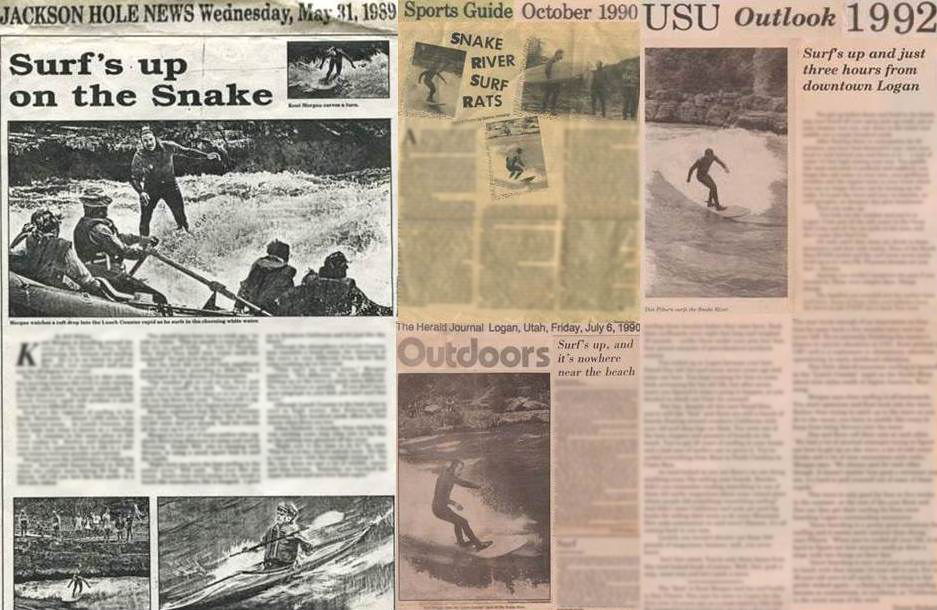

“It’s interesting to see all the video clips being posted these days of mega-surf stars trying their hand at River Surfing. The struggle for acceptance now seems to be paying off. The major surf publications rarely gave river surfing even the least bit of press back then. When we shared what we were doing with our contacts, the sport was habitually dismissed as a “novelty.” Well this “novelty” is now getting legs under it.
Dodging ski poles was a minor reflection of how the ski industry at first tried to write snowboarding off as a novelty when that was first starting. In winter of 1973 Seal wasn’t allowed to take his Snurfer up onto the lifts in Tahoe, California. In 1985, I was one of five snowboarders in the whole county where I lived in Northern Utah. We were all displaced surfers and called it “Snow Surfing.” The last paragraph notes that Beaver Mountain Ski Resort was the only mountain in Utah, the same future home of the breakout 2002 Olympic half-pipe events, that allowed snowboarders onto their lifts. Seeing all this progress brings us no small bit of satisfaction.”
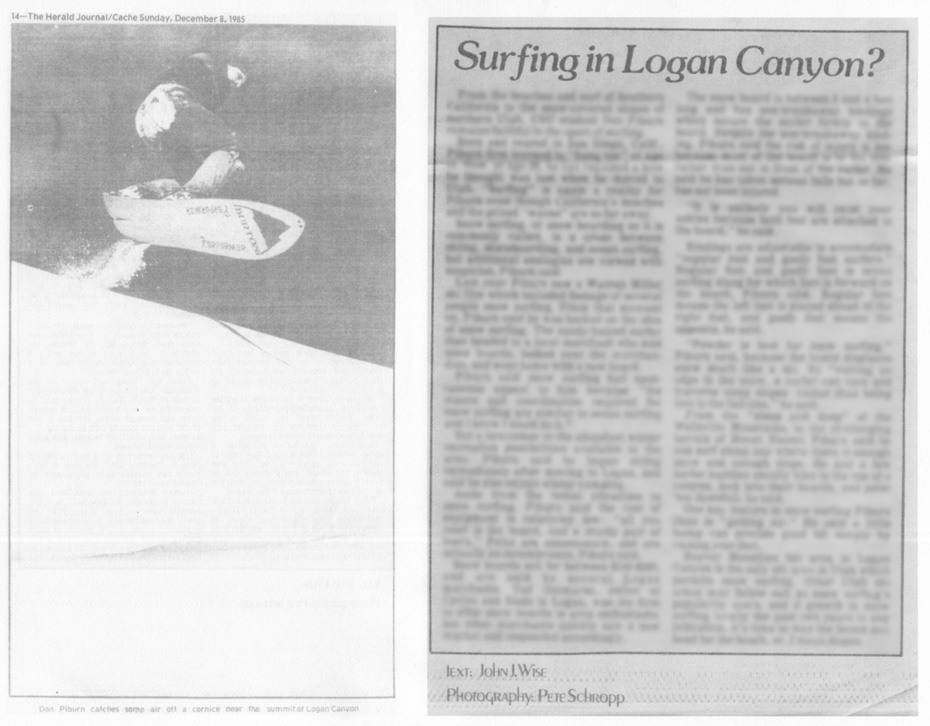

“Rivers can and do kill. To this very day many river surfers treat wild rivers like they are some of kind of waterpark, which they are absolutely not. A flood stage river at high water levels is gnarly, and people can and did die on the Alpine Canyon stretch of the Snake River during those very same years that we surfed there. We were continuously checking upstream for approaching rafts, but in big water somebody was ALWAYS assigned to act as a sentry. When we were there by ourselves, that individual also doubled as the de facto lifeguard. Sentries were charged not only to watch upstream for all the little bits of crap and board damaging debris, but more importantly to shout out a warning when logs that had been dislodged by the flood waters came around the bend. Someone would scream “LOG!” and everybody: kayakers, rafters, surfers, or whoever would scramble the hell off the wave and get out of the way. You didn’t wait. You moved when you heard that warning. The trees often got pushed directly through the center of the surfing wave into the same downstream eddy that we relied on to exit the river. Waterlogged trees were the worse, because they might not rise to the surface until they hit the stone ledge that creates the very wave we rode. That would shove them sometimes brutally to the surface, and to avoid that happening right in front of the surfer or kayaker who was up and riding, everyone kept a very close watch.”

“What are you supposed to do when a soggy 120 foot conifer suddenly broaches in front of you like some kind of whale? We’ve seen trees that big go dead-on through the wave where someone was riding just 30 seconds earlier. There weren’t any lifeguards, so it was up to all of us to watch out for each other. And it was communal: the kayakers, surfers, rafters, and everybody else took care to watch out for one another. It didn’t matter who you were or what you were riding, there were always lookouts upstream and someone ready to go after anybody who got into trouble.”
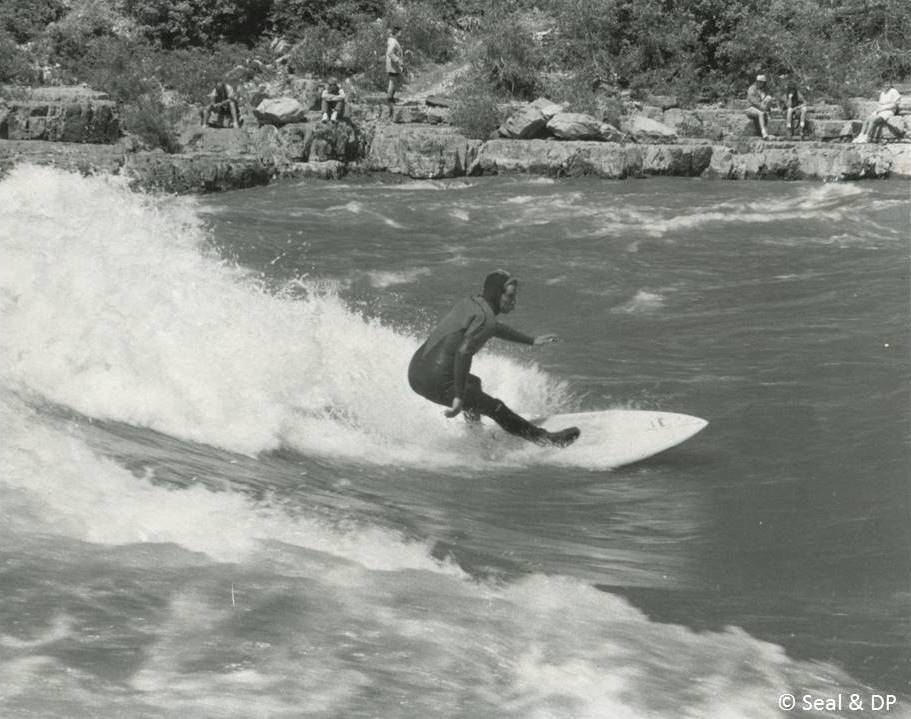

“On one big water occasion, I recall that a family’s closest companion followed its masters into the flooded river when their raft upended on the very same wave we surf. The young black Labrador had no flotation and was immediately swept into the eddy line that we punched each and every time to get out of the water. The dog went directly into the whirlpool that circulates there in big water. Seal pointed out the carcass when it finally resurfaced a solid forty-five minutes later. Not surprising to some of us, it came up in the exact same spot where it went down. One of the kayakers went after the poor pooch and pulled it across the front of his kayak to take downstream to where the rafters had pulled out downriver. Everyone was shedding tears when the body finally surfaced. It was a really sad moment and gave us all serious pause, because we wipe out immediately into that same spinning vortex that had held him down for so very long. And we didn’t wear life vests either.”
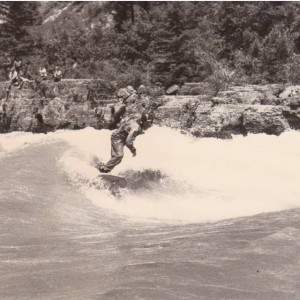 Dry Suit River Surfing, 1988Dry Suit on Seal Team-Fish, 1988.© DP & Seal
Dry Suit River Surfing, 1988Dry Suit on Seal Team-Fish, 1988.© DP & Seal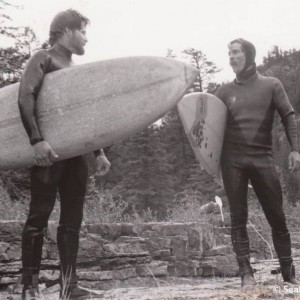 Black & White DP & Seal, 1990DP holding the Seal Team Rider Fish twinfin.© Seal & DP
Black & White DP & Seal, 1990DP holding the Seal Team Rider Fish twinfin.© Seal & DP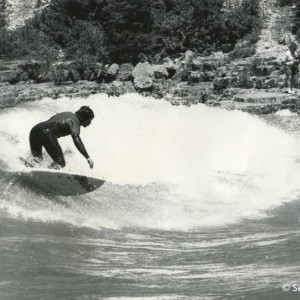 Black and White Still, 1989Lunch Counter black and white shot, 1989© Seal & DP
Black and White Still, 1989Lunch Counter black and white shot, 1989© Seal & DP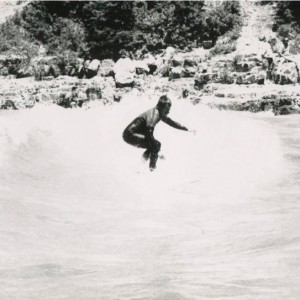 Lunch Counter Back in the Days, 1990Black & White a bit larger.© Seal & DP
Lunch Counter Back in the Days, 1990Black & White a bit larger.© Seal & DP

“One very cold and gray weekend a couple of body boarders, a younger man and woman, showed up. It was really, really cold that day. It was gray, overcast, and threatening snow. It was miserable camping, but an excellent wave. Big water! We showed them the quickest and easiest way we knew to ferry across, but it wasn’t working for her. The poor woman got dragged through the entire stretch of the ‘counter the first three times she tried to get across the river Each time she got carried through, she had to paddle back to the road side and scramble upriver along the rugged bank all the way back to the flat water crossing above the wave. She was so worn out by that forth attempt that our kayaker friend Dennis Will paddled over to shadow her and try to assist. She made it across, but she was very nearly dragged through the rapids yet again. Her guy was there on the rocks, and he was able to grab her before that happened. He went on to ride the wave fairly well, but she was spent. Dennis towed her back across later on, because she was too exhausted to even contemplate tackling it on her own again. The water was 39′ that day, and the air temperature was no different. It pulled the heat right out of you.”

“On another big water day I was standing on a ledge just upstream of the primary wave waiting out a passing raft. I noticed one of its occupants was another surfer wearing a wetsuit and with a surfboard under his arm. “Cool. Another surfer!” was my passing thought. I returned my gaze to whatever might be coming at me from upstream, because I was next on deck to surf the wave.
A couple of river runners were sitting on the bank just upriver of me watching the goings-on, when suddenly a look of terror and concern flashed across their faces. I spun around just in time to see the same surfboard from the raft now separated from its owner and cartwheeling through the air above the river. In that same instant I saw Seal leap off the six-foot rock embankment clear out onto the secondary wave, something anyone intent on river surfing had no cause to do. From water level I could not see what was happening downriver at that point, but I surmised that he was in some kind of big trouble.”
_______________________
Don Piburn is a surfer, ’70s outlaw skateboarder, ’80s backhill snowboarder, and late ’80s Snake River surfer. He moved to Oah’u in the ’90s where he continues a 30+ year career teaching infants, toddlers, and preschoolers with disabilities, surfs north shore, kayaks windward reefs, and takes weekly hikes with his Hawaii born and raised wife, Janice.
Seal Morgan teaches free snowboard lessons at 49′North, Kenpo in home dojo, skates 70s pool riders, wakesurfs old Hyperlites, surfs Olympic Peninsula summers on twinfins, plays mean lead blues harp and congas, and builds custom winter gear for locals in his Selkirk Range of NE Washington State sew shop www.boardwarm.com. No tv since ’93, never owned a cell phone, leaving plenty of time to read and think.

